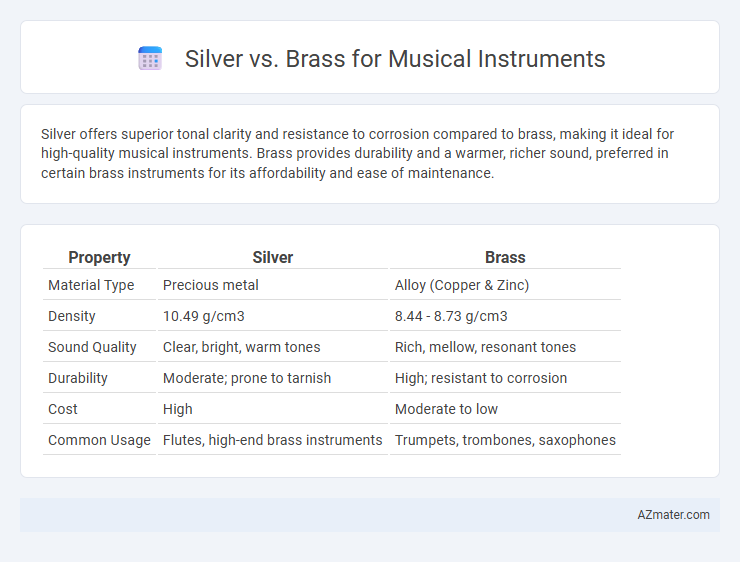Silver offers superior tonal clarity and resistance to corrosion compared to brass, making it ideal for high-quality musical instruments. Brass provides durability and a warmer, richer sound, preferred in certain brass instruments for its affordability and ease of maintenance.
Table of Comparison
| Property | Silver | Brass |
|---|---|---|
| Material Type | Precious metal | Alloy (Copper & Zinc) |
| Density | 10.49 g/cm3 | 8.44 - 8.73 g/cm3 |
| Sound Quality | Clear, bright, warm tones | Rich, mellow, resonant tones |
| Durability | Moderate; prone to tarnish | High; resistant to corrosion |
| Cost | High | Moderate to low |
| Common Usage | Flutes, high-end brass instruments | Trumpets, trombones, saxophones |
Introduction to Silver and Brass in Musical Instruments
Silver and brass are commonly used materials in the construction of musical instruments, each offering distinct acoustic properties. Silver, often employed in flutes and high-quality brass instruments, is prized for its bright, clear tone and excellent resonance, enhancing the instrument's projection and sound clarity. Brass, an alloy of copper and zinc, is favored for its durability and warm, rich sound, making it a standard choice for trumpets, trombones, and saxophones.
Historical Use of Silver and Brass
Silver has been historically favored for musical instruments such as flutes and piccolo due to its excellent acoustic properties and resistance to corrosion, enhancing sound clarity and durability. Brass, used extensively in instruments like trumpets and trombones since the Renaissance, offers robust tonal qualities and ease of manufacturing, contributing to its widespread adoption in military and orchestral bands. The distinct tonal characteristics of silver and brass have shaped their roles in musical ensembles, with silver instruments prized for their bright, clear sound and brass instruments known for their powerful, resonant tones.
Acoustic Properties: Sound Differences
Silver produces a brighter and more focused tone with enhanced projection and clarity, making it ideal for instruments requiring sharp articulation and crisp sound. Brass offers a warmer, richer timbre with greater resonance and versatility, providing a rounded sound favored in orchestral and jazz settings. The denser composition of silver results in faster vibrations and a more direct sound, while brass's softer alloy contributes to a mellow, complex acoustic profile.
Durability and Maintenance
Silver offers superior durability compared to brass, resisting corrosion and wear better over time, making it ideal for musicians seeking long-term reliability in their instruments. Brass, though less expensive, requires regular polishing and cleaning to prevent tarnish and maintain its appearance, increasing maintenance efforts. Silver's resistance to environmental factors reduces the frequency of repairs and upkeep, enhancing the instrument's lifespan and consistent performance.
Weight and Playability
Silver offers a lighter weight compared to brass, enhancing comfort and reducing fatigue during extended play sessions. The lighter density of silver allows for quicker response and increased agility, improving overall playability. Brass, being heavier, provides a more robust feel but can lead to quicker fatigue, especially for beginners or players performing long pieces.
Cost Comparison: Silver vs. Brass Instruments
Silver musical instruments generally come with a higher price tag than brass counterparts due to the cost of raw materials and manufacturing processes. Brass instruments offer a more affordable option, making them popular among beginners and budget-conscious musicians. The resale value of silver instruments tends to be stronger, often making them a long-term investment despite the initial expense.
Popular Instruments Made from Silver and Brass
Silver is commonly used in high-quality flutes and saxophones, prized for its bright, clear tone and corrosion resistance, making it a favorite among professional woodwind players. Brass, an alloy of copper and zinc, is the standard material for trumpets, trombones, and tubas, valued for its durability and rich, warm sound that projects well in orchestras and bands. Instruments like silver trumpets or flutes often command premium prices, while brass instruments dominate the brass family due to their versatility and strong acoustic properties.
Preferences Among Professional Musicians
Professional musicians often favor silver for its bright, clear tonal qualities and smooth response, making it ideal for instruments like flutes and trumpets in orchestral settings. Brass, preferred for its warmth and rich, resonant sound, is commonly chosen for saxophones and trombones, providing depth and versatility in diverse musical genres. The choice between silver and brass ultimately depends on the desired sound projection, timbre, and playing style within professional performances.
Aesthetic Appeal and Finish
Silver offers a bright, reflective surface that enhances the visual allure of musical instruments, often preferred for its elegant and polished finish. Brass provides a warm, golden tone with a naturally aged patina that musicians appreciate for its vintage and classic look. Both metals respond uniquely to polishing and lacquer, affecting durability and long-term aesthetic appeal.
Choosing the Right Material for Your Needs
Silver offers superior tonal clarity and brightness, making it ideal for professional musicians seeking precise sound in instruments like flutes and trumpets. Brass provides warmth and durability at a more affordable price, often preferred for beginner and intermediate brass instruments such as trombones and saxophones. Selecting between silver and brass depends on your playing style, desired sound quality, and budget constraints.

Infographic: Silver vs Brass for Musical Instrument
 azmater.com
azmater.com